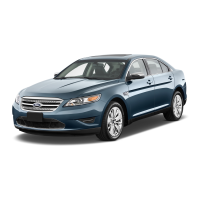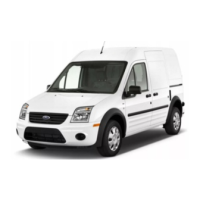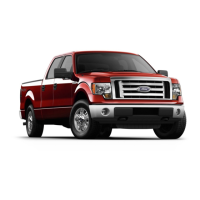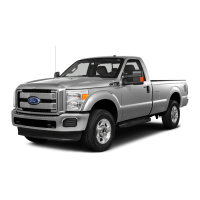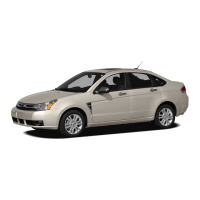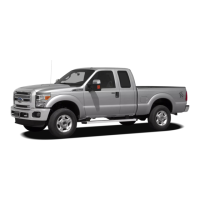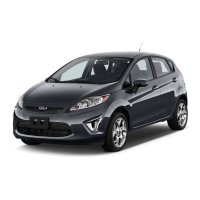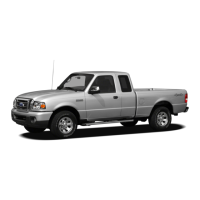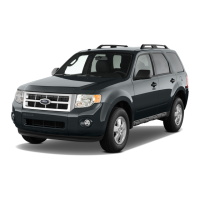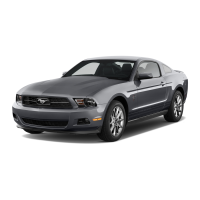
 Loading...
Loading...
Do you have a question about the Ford 2011 Taurus and is the answer not in the manual?
| Brand | Ford |
|---|---|
| Model | 2011 Taurus |
| Category | Automobile |
| Language | English |
Standard instrument cluster shown, optional cluster similar. Discusses warning lights and their function.
Speedometer: Indicates the current vehicle speed. Describes speedometer and engine coolant temperature gauge.
Your vehicle’s message center allows you to configure/personalize certain vehicle options.
AM/FM CD/MP3 satellite compatible sound system. Introduces the audio system with a warning about distracted driving.
Press to enter CD/MP3 mode. Describes loading, playing, and ejecting CDs.
Satellite radio is available only with a valid SIRIUS radio subscription. Explains SIRIUS radio, TUNE, DIRECT, SEEK, SCAN, MEMORY PRESETS.
Your vehicle is equipped with an auxiliary input jack (AIJ). Explains how to play music using the AIJ.
Do not connect the audio input jack to a line level output. Provides troubleshooting tips for AIJ and USB port.
Satellite radio channels: SIRIUS broadcasts a variety of music, news, sports, weather, traffic and entertainment channels.
Temperature conversion: To switch between Fahrenheit and Celsius, refer to Message center.
Temperature conversion: To switch between Fahrenheit and Celsius, refer to Message center.
Temperature conversion: To switch between Fahrenheit and Celsius, refer to Message center.
The cabin air filter element is designed to reduce the concentration of airborne particles.
Turns the lamps off. Turns on the parking lamps, instrument panel lamps, license plate lamps and tail lamps.
The autolamp system provides light sensitive automatic on-off control of the exterior lights.
During nighttime driving, the automatic high beam system automatically turns on your high beams.
Use to adjust the brightness of the instrument panel and all applicable lit components.
Lamp assembly condensation can be a natural by-product of this design.
Windshield wiper: Rotate the end of the control away from you to increase the speed of the wipers.
To adjust the steering wheel: Pull the lever down to unlock the steering column.
Perform compass calibration in an open area free from steel structures and high voltage lines.
Power outlets are designed for accessory plugs only.
Press and pull the window switches to open and close windows.
Power side view mirrors WARNING: Do not adjust the mirror while the vehicle is in motion.
The accelerator and brake pedal should only be adjusted when the vehicle is stopped.
With speed control set, you can maintain a set speed without keeping your foot on the accelerator pedal.
Adaptive cruise control is much like speed control, only this system is designed to automatically adjust your speed.
The distance between your vehicle and the vehicle in front of you can be decreased or increased.
There are three ways to change the set speed:
Radio control features VOL + (Volume): Press to increase the volume.
Press briefly to use the voice command feature.
The moon roof control is located on the overhead console.
Your vehicle may be equipped with a universal garage door opener which can be used to replace the common hand-held transmitter.
The HomeLink Wireless Control System, located on the driver’s visor, provides a convenient way to replace up to three hand-held transmitters.
To operate, simply press and release the appropriate HomeLink button.
Integrated keyhead transmitters (IKTs) (If equipped) Your vehicle may be equipped with two integrated keyhead transmitters (IKTs).
Your vehicle may be equipped with two intelligent access keys which operate the power locks and the remote entry systems.
The MyKey™ feature allows you to program a restricted driving mode to promote good driving habits.
Standard settings – these settings cannot be changed
To program MyKey™ on one of the keys programmed to the vehicle, insert the key that you want to make a MyKey™ into the ignition.
Turn the ignition on using an admin key.
To reset all MyKeys™ as admin keys, do the following:
Press the control to unlock all doors.
The smart unlock feature is intended to prevent you from unintentionally locking your IA key inside your vehicle’s passenger compartment or trunk.
The autolock feature will lock all the doors when: all the doors are closed, the ignition is in the on position.
Before starting, ensure the ignition is off and all vehicle doors are closed.
Turn the ignition off. Enter factory–set 5–digit entry code.
The autounlock feature will unlock all the doors when: the ignition is on, all the doors are closed, and the vehicle has been in motion.
The intelligent access keys (IA key) comply with part 15 of the FCC rules.
Your vehicle is equipped with a push button start system, which allows you to start your vehicle without using a key.
The integrated keyhead transmitter (IKT) or intelligent access key (IA key) uses one coin type three-volt lithium battery CR2032.
The keypad, located near the driver’s window, is invisible until touched and then it lights up.
SecuriLock passive anti-theft system is an engine immobilization system.
The perimeter alarm system will help protect your vehicle from unauthorized entry.
To disarm the system, do any of the following: Unlock the doors by pressing unlock on the remote entry transmitter.
WARNING: Reclining the seatback can cause an occupant to slide under the seat’s safety belt.
WARNING: Never adjust the driver’s seat or seatback when the vehicle is moving.
WARNING: Never adjust the driver’s seat or seatback when the vehicle is moving.
The multi-contour seat consists of the following: the massage control, the lumbar control, and the power seat controls.
Heated seats The heated seats will only function when the engine is running.
Personal Safety System™ The Personal Safety System provides an improved overall level of frontal crash protection.
The Personal Safety System provides an improved overall level of frontal crash protection to front seat occupants.
WARNING: Always ride and drive with your seatback upright and the safety belt properly fastened.
The safety belt warning light illuminates in the instrument cluster and a chime sounds.
The Belt-Minder feature is a supplemental warning to the safety belt warning function.
The driver and front passenger Belt-Minder are deactivated/activated independently.
The airbag supplemental restraint system (SRS) is designed to work in conjunction with the safety belts.
Airbags DO NOT inflate slowly or gently and the risk of injury from a deploying airbag is greatest close to the trim.
Children must always be properly restrained. Accident statistics suggest that children are safer when properly restrained in the rear seating positions.
The airbag SRS is designed to activate when the vehicle sustains longitudinal deceleration sufficient to cause the sensors to close an electrical circuit.
The front passenger sensing system is designed to meet the regulatory requirements of Federal Motor Vehicle Safety Standard (FMVSS) 208.
The front passenger sensing system is designed to meet the regulatory requirements of Federal Motor Vehicle Safety Standard (FMVSS) 208.
WARNING: Do not place objects or mount equipment on or near the airbag cover on the side of the seatbacks.
The design and development of the side airbag system included recommended testing procedures.
WARNING: Do not place objects or mount equipment on or near the headliner at the siderail.
See the following sections for directions on how to properly use safety restraints for children.
WARNING: Always make sure your child is secured properly in a device that is appropriate for their height, age and weight.
Child size, height, weight, or age Recommended restraint type
Check to make sure the child seat is properly secured before each use.
The LATCH system is composed of three vehicle anchor points: two (2) lower anchors.
The belt-positioning booster (booster seat) is used to improve the fit of the vehicle safety belt.
Inspect the vehicle safety belts and child safety seat systems periodically to make sure they work properly.
Safe operation of your vehicle requires that your tires are properly inflated.
WARNING: When mounting replacement tires and wheels, you should not exceed the maximum pressure indicated on the sidewall of the tire.
Each tire, including the spare (if provided), should be checked monthly when cold and inflated to the inflation pressure recommended.
The tire pressure monitoring system measures pressure in your four road tires and sends the tire pressure readings to your vehicle.
This section will guide you in the proper loading of your vehicle and/or trailer, to keep your loaded vehicle weight within its design rating capability.
Payload – is the combined weight of cargo and passengers that the vehicle is carrying.
GAWR (Gross Axle Weight Rating) – is the maximum allowable weight that can be carried by a single axle (front or rear).
GVWR (Gross Vehicle Weight Rating) – is the maximum allowable weight of the fully loaded vehicle.
1. Locate the statement “The combined weight of occupants and cargo should never exceed XXX kg or XXX lbs.” on your vehicle’s placard.
Your vehicle is capable of towing a trailer up to 1,000 lb (454 kg) gross trailer weight.
Positions of the ignition (if equipped) If your vehicle is equipped with a push button start system, refer to Push button start system.
If your vehicle is equipped with the push button start system, you can start your vehicle by pressing the start button.
Your vehicle is equipped with an anti-lock braking system (ABS). This system helps you maintain steering control during emergency stops.
The brake assist system provides full braking force during panic braking situations.
Apply the parking brake whenever the vehicle is parked.
Your vehicle is equipped with the AdvanceTrac system. The AdvanceTrac system provides the following stability enhancement features.
The traction control system is a driver aid feature that helps your vehicle maintain traction of the wheels, typically when driving on slippery surfaces.
Electronic stability control (ESC) may enhance your vehicle’s directional stability during adverse maneuvers.
WARNING: Do not drive your vehicle until you verify that the brake lamps are working.
Your vehicle has been designed to improve fuel economy by reducing fuel usage while coasting or decelerating.
The reverse sensing system (RSS) sounds a tone to warn the driver of obstacles near the rear bumper.
The rearview camera is located on the trunk, under the spoiler for the SHO, or under the Ford badge for all other models.
The collision warning with brake support, is designed to alert the driver of certain collision risks with a red warning light.
If a message regarding a blocked sensor is displayed, the radar signals from the sensor have been obstructed.
The BLIS is a convenience feature that aids the driver in assessing whether a vehicle is within an area on either side of the vehicle.
Your vehicle may be equipped with a full-time All Wheel Drive (AWD) system.
In an unavoidable emergency situation where a sudden sharp turn must be made, remember to avoid “over-driving” your vehicle.
Ford Motor Company offers a complimentary roadside assistance program.
In the event of a moderate to severe collision, this vehicle is equipped with a fuel pump shut-off feature.
If electrical components in the vehicle are not working, a fuse may have blown.
If you get a flat tire while driving, do not apply the brake heavily.
WARNING: When one of the front wheels is off the ground, the transmission alone will not prevent the vehicle from moving.
Your vehicle may be equipped with a temporary mobility kit (located in the spare tire well in the trunk).
Read the following list of tips to ensure safe operation of the temporary mobility kit:
A tire puncture within the tire’s tread area can be repaired in two stages with the temporary mobility kit:
Preparation Park the vehicle in a safe, level and secure area, away from moving traffic.
WARNING: The gases around the battery can explode if exposed to flames, sparks, or lit cigarettes.
If you need to have your vehicle towed, contact a professional towing service.
Warranty repairs to your vehicle must be performed by an authorized Ford, Lincoln, or Mercury dealer.
If you believe that your vehicle has a defect which could cause a crash or could cause injury or death, you should immediately inform the National Highway Traffic Safety Administration (NHTSA).
If you believe that your vehicle has a defect which could cause a crash or could cause injury or death, you should immediately inform Transport Canada.
Wash your vehicle regularly with cool or lukewarm water and a neutral pH shampoo.
To help you service your vehicle, we provide scheduled maintenance information which makes tracking routine service easy.
• Do not work on a hot engine. • Make sure that nothing gets caught in moving parts.
Checking the engine oil Refer to the scheduled maintenance information for the appropriate intervals for checking the engine oil.
Your vehicle is equipped with a Motorcraft maintenance-free battery which normally does not require additional water.
If the engine begins to overheat: The engine coolant temperature gauge will move to the red (hot) area.
WARNING: Fuel vapor burns violently and a fuel fire can cause severe injuries.
Use only UNLEADED fuel or UNLEADED fuel blended with a maximum of 10% ethanol.
Your vehicle is equipped with various emission control components and a catalytic converter which will enable your vehicle to comply with applicable exhaust emission standards.
Your vehicle is equipped with a computer that monitors the engine’s emission control system.
Checking automatic transmission fluid Refer to your scheduled maintenance information for scheduled intervals for fluid checks and changes.
Refer to scheduled maintenance information for the appropriate intervals for changing the air filter element.
Items Capacity Ford Part Name or equivalent Ford Part Number / Ford Specification
Safety Compliance Certification Label The National Highway Traffic Safety Administration Regulations require that a Safety Compliance Certification Label be affixed to a vehicle.
The vehicle identification number is located on the driver side instrument panel.
A wide selection of Ford Custom Accessories are available for your vehicle through your local Ford or Ford of Canada dealer.
More than 30 million Ford, Lincoln, and Mercury owners have discovered the powerful protection of Ford ESP.
Ford ESP Can Quickly Pay for Itself One service bill – the cost of parts and labor – can easily exceed the price of your Ford ESP Service Contract.
One service bill – the cost of parts and labor – can easily exceed the price of your Ford ESP Service Contract.
You can get more protection for your vehicle by purchasing a Ford Extended Service Plan (ESP).
Why maintain your vehicle? This guide describes the scheduled maintenance required for your vehicle.
For your convenience, your vehicle is equipped with a message center which determines the proper oil change service interval.
In order to keep your vehicle running right, it is important to have the systems on your vehicle checked regularly.
If you operate your Ford/Lincoln/Mercury vehicle primarily in one of the more demanding Special Operating Conditions listed below.
As required – Change engine oil and replace oil filter as indicated by message center and perform services as listed in the Normal Scheduled Maintenance chart.
As required – Change engine oil and replace oil filter as indicated by message center and perform services as listed in the Normal Scheduled Maintenance chart (except Fiesta).
